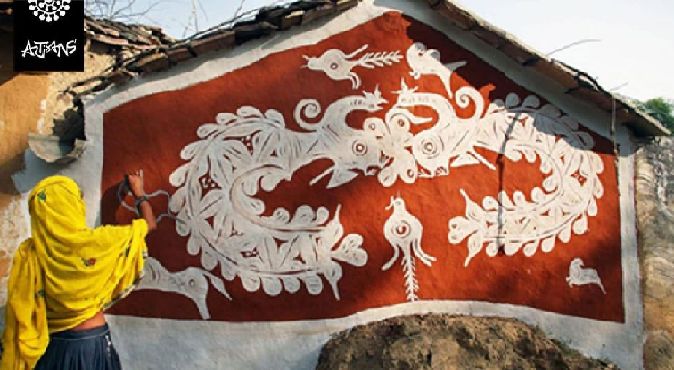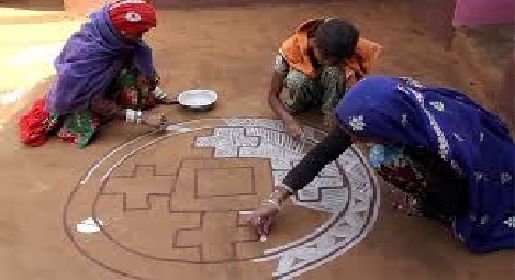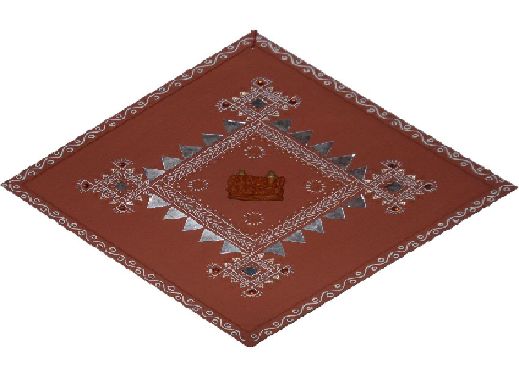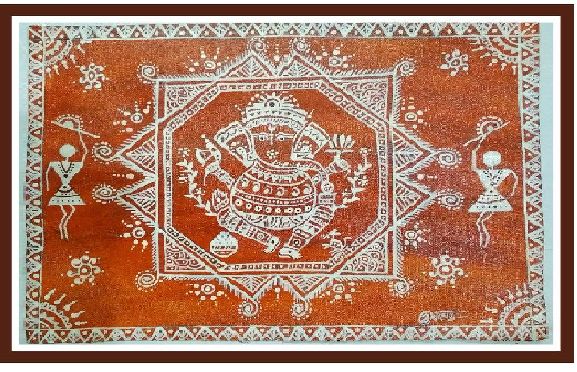Mandana Art
Sep 14, 2019 • 736 views
Background of Mandana
Mandana which literally means 'drawing' in Gujjar Bhakha language, is one of the oldest tribal art forms of India that has managed to survive and stand the test of time. Despite the lack of records, the designs and shapes used in the art give evidence to it dating back to 1500 BCE which is considered as the period of Vedic Age in Indian subcontinent. Derived from the word 'Mandan' which means beautification and decoration, this art form originated in the states of Rajasthan and Madhya Pradesh. The credit for its birth and development goes to the people of one of the oldest tribal communities, the Meenas. This art form is generally practiced by women, and the evidence of their skills and mastery is seen in the perfectly symmetrical and accurate designs made by the women of the Sawai Madhopur area in the state of Rajasthan.
Designs and style
Mandana paintings are originally drawn both inside and outside the house. In states like Madhya Pradesh they are restricted to floors only, but the walls and floors of the houses in Rajasthan both are covered with this art. Like every other art form, Mandana paintings too have their own procedures and a certain way to use different materials. These methods and resources are the requisites to create a perfect piece of Mandana art.

Mandana Art Outside the House- Source: Events High
The very first step when beginning with Mandana art is the preparation of the floor or the wall, that is, making them suitable for the paintings. This arrangement is done by plastering the walls or the floors with a base which is basically a mixture prepared by combining cow dung, local clay, rati, red ochre and water. After the application of the base, the surface is left to dry. Following this, the designs are made using a pasty substance prepared by mixing lime or chalk powder with water. Earlier, due to the absence of brushes (as we perceive today), date twigs, wick of cotton or clump of hair were used as brushing tools. When the whole design is prepared and it has completely dried, the next step is to fill the painting with colours. Mandana art makes use of just two basic colours as a part of its colour scheme which are red and white. The white colour or khadiya and the red colour or geru are authentically prepared using chalk and bricks respectively. These paints are then used to fill in the motifs that are drawn.
Mandana art though is very simple in its use of materials and colours, it is enriched with deep meanings which become evident when we take a look into its designs and patterns and try to understand them. The pivotal themes around which most of the Mandana art revolves are religion, culture and wildlife. The ideas that govern the motifs and designs in the paintings are drawn from the beliefs related to good omens and felicitousness. The motifs can together be tied to the words ‘Shubh Manglik’. Plants, trees, birds and animals are the elements that are seen in paintings which follow the wildlife theme. Others which are inspired from religious and spiritual stories and beliefs, draw different forms of Gods, Goddesses and other deities. Some very popular and common figures include peacocks, tigers, Lord Ganesha and vedic yagnas. Some prominent variety and designs of Mandanas include ‘Tapki Ke Mandanas’ and the motifs ‘jaali’ or lattice screen. Both of them, to a great extent are inspired by the Indian architectural designs. Where on one hand ‘Tapki Ke Mandanas’ employ geometric figures like triangles, rectangles, squares etc, the ‘jaali’ motifs mimic the original jaalis used in architecture.

Wildlife Influenced Mandana Art- Source: Indipool
The beauty of Mandana Art lies in its visual simplicity and insightful meanings.
Social and Traditional Significance
Mandana art is strongly connected with the traditions and cultural beliefs of the people and society in which it originated. The women of the Meena community used this art to decorate houses and temples, especially during festivals and auspicious occasions like communal religious worships, marriages, birth of a child etc. The art form is believed to be a symbol of fortune and protection against bad omens and evil spirits. They are greatly entwined with the spiritual beliefs of the people.
Apart from their religious connections, Mandana art is also a form of legacy passed on from mothers to their daughters. It established a stronger bond between a mother and her daughter for the latter would watch her mother carefully, absorbing the methods and techniques and thus always carrying a part of her mother with herself.

Mother and Daughter Together Drawing Mandana Painting Source: Caleidoscope
Mandana Art in the Present
Mandana art is one of the few folk-art forms that have survived till now. But over this long time period, the art form has seen its fair share of ups and downs. The very first problem that is resulting in its decline is the paintings being authentically drawn on mud walls and floors. The growing urbanization has limited this art to the villages only. Another problem is that there is no instruction manual or teaching methods for Mandana art as from the time of its origin, it has been like those folk tales which are passed from one generation to another. Despite all this, a number of ways have come up using which this art form is being tried to revive. These new innovations include the adaptation of the designs on hard boards and cloth which results in products like sarees, dupattas etc. This art is being used in various forms to bring the aesthetic elements into objects.

Mandana Art Wall Piece - Source: Snapdeal

Mandana Art on Hard Board - Source: Twitter
Interesting Facts
Mandana Art acts as an excuse for communal gatherings where women come together and draw different designs and enjoy.
This art form is also practised in parts of Nepal and is called Mandala painting there.
Often elements of Mandana Art are used while making rangolis as they both serve the same purpose, that is to welcome fortune and ward off evils.
Desert Resort is a hotel in Rajasthan whose exteriors showcase Mandana Art which are redone almost every day by the village women.
